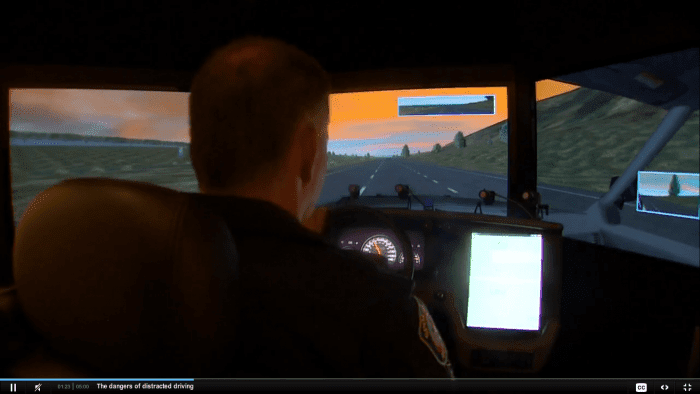At any giving time, a police officer could be responding to a call, checking the in-dash computer – and driving a car.
Officers are trained to multitask behind the wheel, but how well does that work?
Washington State Distracted Driving Simulator
Washington State University in Spokane set up a distracted driving simulation for police officers.

The officers were tasked with:
- Driving 55 miles per hour;
- Staying in their own traffic lane;
- Avoiding obstacles;
- And keeping a 100-foot distance from a car with an erratic driver.
Researchers measured eye movements and reaction time as officers performed common job tasks, liking reading from their onboard computers.
“What we’re trying to do is both identify what impairs police officers or interferes with their optimal performance and how much the risk of a problem is…”
– Bryan Vila, lead researcher at WSU
Dozens of police officers have participated in the research, each logging hours of driving a computer-simulated squad car. Officers were better than student study participants at managing all of the distractions.
But they were still seven times more likely to crash when distracted.
This is a big problem.
Cops log a lot of miles – tens of thousands per year, depending on the jurisdiction. Officers are involved in far more car crashes than other drivers. In many places, police officers are more likely to die of a motor vehicle accident than a gunshot.
An investigation in Colorado found local police responsible for hundreds of collisions in a 3-year period. In the Washington, D.C. metro area, police officers were found at-fault in 2300 crashes in 4 years, ranging from minor vehicle damage to fatal injuries.
“Three easy solutions”
Bryan Vila, the lead researcher for the WSU study, is an expert on the science of distracted driving.
There are “three easy solutions” to the police officer distracted driving issue, Vila says.
- Move the onboard computer. Change the position of the in-dash technology, so it’s not competing with the road for the officer’s attention.
- Automatic shut-off. Vila suggests that the onboard computer should turn off automatically if the vehicle is moving faster than 10-15 mph.
- Divide and conquer. If there are two officers in the car, one is driving, and the other is in charge of communications.



